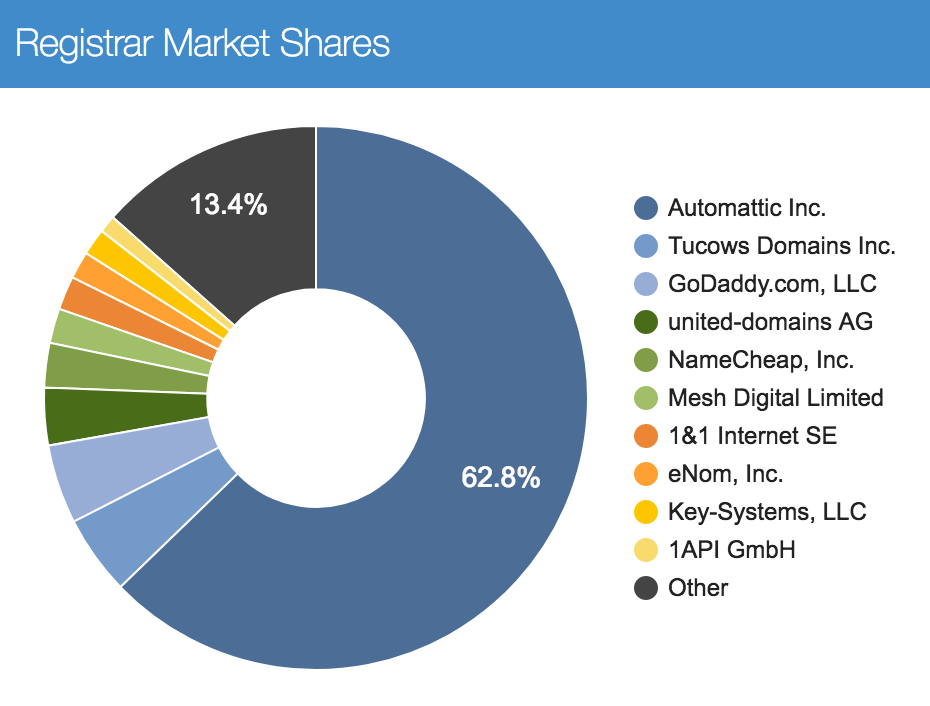The .blog domain extension, managed by Automattic subsidiary Knock Knock WHOIS There (KKWT), opened registration to the public in November 2016 and has just passed the 100,000 registration milestone. The extension is averaging 300 new .blog domains registered per day and is quickly gaining popularity among new generic TLDs. According to the most recent stats available at nTLDStats, .blog registrations have climbed steadily and predictably every month since its public launch.

Automattic, which operates independently from KKWT as a registrar, currently has the largest market share of .blog domain registrars at 62.8%. Other smaller pieces of the pie continue to see increasing numbers of registrations.
“When a .blog domain is sold through any .blog registrar, it operates like all other top-level domains (TLDs),” .blog representative Erica Varlese said. “This means that the registry, in this case Knock Knock WHOIS There, receives the wholesale cost, ICANN receives their fees, and the registrar retains the rest.”
The .blog team has started experimenting with different marketing programs to promote the extension among registrars and launched its first campaigns last month.
“These programs are available to any .blog accredited registrar and, through participation, allows them to provide .blog domains to their customers at a discounted rate,” Varlese said. “It is designed to test price elasticity and various end-user marketing techniques that best fit each registrars’ unique customer-base.”
Registration for .blog domains is fully integrated into WordPress.com’s domain offerings, but Varlese said that Knock Knock WHOIS There, as a separate company, is not informed of the specific details of their domain roadmap. The subsidiary also does not track how many of the .blog domains are running WordPress, as the extension is platform agnostic and in use across many different blogging services.
So far .blog domain customers include both individuals and businesses, including some e-commerce and community sites. Varlese said the main benefit to acquiring a .blog domain is that customers are more likely to get and use a name they always wanted (example.blog), versus settling for a more complicated variation, such as blog.example.com.
“Using a blog domain is also a great way to embrace engagement with your community,” Varlese said. “In addition to individual and personal bloggers, we also see larger brands using blogs to engage with their customers. Visiting stackoverflow.blog, for example, is intuitive. The domain lets me know right away what type of content and interaction to expect versus what my expectations would be when prompted to visit stackoverflow.com. Both are equally important and both add value to the customer’s online experience.”
Many people purchase a domain just to sit on it for the right time to use it or sell. Greater usage of .blog domains promotes visibility on the web, which is why registrars place value on how many have launched websites using the extension.
“Our goal is steady, long-term growth while continuing to increase our usage rates,” Varlese said. “We want every .blog domain to resolve to a unique content site or blog. Usage is an important metric for us. It positively contributes to help the new TLD marketplace thrive and grow organically. It is at the forefront of every decision we make, including marketing and rebate programs for our registrars, as well as our dotblogger program, which gives online influencers easy access to all .blog domains, including premium and reserved domains.”
The .blog team’s 100,000 registrations milestone post cites usage stats from Pandalytics, a domains data service, that are not publicly available.
“66.5% of .blog domains have a unique website associated with them, compared to an average of 39.3% for both new and legacy TLDs, according to recent research by Daniel Ruzzini-Mejia (co-founder and CSO of DomainsBot Srl, the company behind big-data analysis platform Pandalytics),” Varlese said. “Ruzzini-Mejia also found more than 250 .blog domains that use an eCommerce platform.”
This is an interesting find in an era where many have claimed that blogs are dead. If the indie web proponents have their way, blogs may have another renaissance yet, and could become the anchors of commerce and identity online. The healthy usage numbers the .blog extension has posted in its first year are a strong indicator that the concept of blogging still holds an important place on the web.

